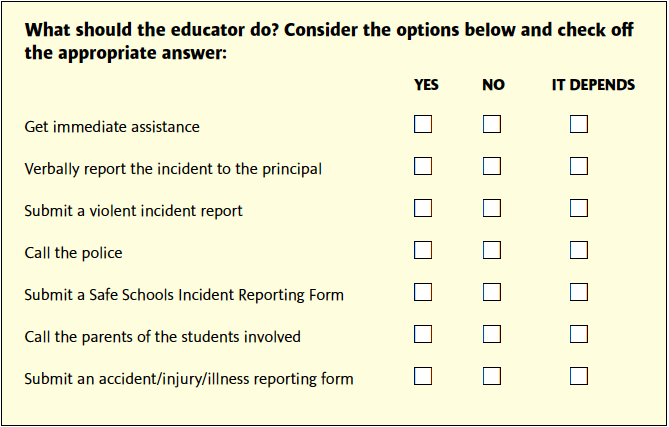
Responding to a Violent Incident
During morning recess duty an educator responds to an altercation among several students. When she arrives at the scene, one of the students, surprisingly, starts yelling and threatens her. Before she can react, the student shoves her very hard, knocking her to the ground.

Not only is the educator dealing with the emotional and physical consequences of the physical aggression and threat, she is now faced with reporting a violent incident. Should she give an oral report or send an email? Which forms should she use to report the incident? Is she getting mixed messages about reporting the incident? Does she still report if there are mitigating factors such as the age of the student or if the student has a safety plan?
Reporting a violent incident is complicated. This is, in part, the result of having two Ministries – the Ministry of Labour (MOL) and the Ministry of Education (EDU) – each with different reporting requirements, regulating violence in the workplace. For example, although the Ministry of Education uses a universal form (Safe Schools Incident Reporting Form) for reporting incidents, By Nicole t te Lane Responding to a Violent Incident including violent incidents, the Ministry of Labour does not require a standard form for school boards across the province. The definition or criteria used for a violent incident is different between the two ministries (see MOL Occupational Health and Safety Act and EDU Policy/Program Memorandum 120). Where the Ministry of Labour defines a violent incident as the actual, attempt or threat of physical force by a person against a worker, the Ministry of Education considers a violent incident one that requires medical attention.
Part of the complexity in reporting violent incidents arises from the number of forms to be completed and by whom. Sometimes one, sometimes both Ministries’ forms need to be completed, sometimes even more. The roles of the administrator and the worker in completing the forms and timelines for completion of the forms vary. In some school boards, the Violent Incident Report is part of the Accident/Injury/Illness/Incident Reporting Form, while in others there are two separate forms to be completed.
The MOL requires that all workplace violent incidents (attempt, threat or actual) directed at a worker be reported, regardless of mitigating factors. The Ministry of Education requires serious student incidents to be reported, but the principal considers mitigating factors when determining whether to suspend or expel a student.
Quite apart from the reporting of a violent incident, there can be uncertainty and indecision regarding the sharing of information about and plans for persons with a history of violence. In many boards and schools, information in the plans intended to protect workers’ safety is only shared with people who work directly with the person/student with a plan. In other boards and schools, the sharing of plans with workers is much broader and includes those who work directly with the person/student as well as staff who may encounter the person/ student during the school day. The Ministry of Labour entrenches a worker’s “Right to Know” about a person with a history of violence “if they can be expected to encounter the person and the risk of workplace violence is likely to expose them to physical injury.” This would include educators on duty in the hallway and occasional teachers/ DECEs/ESPs/PSPs who can be expected to encounter the student. The Ministry of Labour also provides teachers with a limited “Right to Refuse” unsafe work, also a subject of confusion and debate. How does the educator in this scenario proceed post-violent incident? How does she make sure she is meeting her responsibilities and that others are fulfilling theirs? How does she ensure her rights have been respected? And ultimately, how does she ensure a greater degree of safety is achieved for herself and her students?
How Should This Educator Proceed?
One of the first things the educator needs to do in this situation is summon immediate assistance. Members of the school’s response team may need to intervene. This team is made up of school staff trained to deal with escalations who can support other staff. It could be comprised of educational assistants, child and youth workers, educators and administrators. If there is a history of violent behavior by the student there should be a plan in place for responding to the student and the situation.
If required, the educator should get immediate first aid or medical attention. If medical attention is required on the day of the incident, it is the responsibility of the principal to arrange for transportation to a medical facility during the working day. When seeking medical attention, it is important not only to deal with any physical injuries but also to inform the medical practitioner of any psychological and emotional harm resulting from this incident. This enables the medical practitioner to determine if there is a need for further treatment and to document this as an incident causing psychological and emotional harm. The educator will need to complete a WSIB Form 6 because medical attention was sought.
Depending on the circumstances of this violent incident and the reporting procedures in this educator’s board, other reporting requirements may have to be considered.
Regardless of whether the educator’s injury required first aid or medical attention she is required to submit her board’s accident/injury/illness/incident reporting form. Even if an injury or illness is not immediately apparent, it is best to report the incident because an injury or illness may become evident later. Not reporting could put a possible WSIB claim in jeopardy.
In our scenario, the educator was threatened, physically shoved and knocked to the ground. Because physical force was applied and there was a threat against her, this is a violent incident as defined in the Occupational Health and Safety Act and must be reported as a violent incident on a reporting form.
Because students are involved and it is a serious incident, a Safe Schools Incident Reporting Form – Part 1 must be completed under the requirements of the Education Act. There are two incidents involved here: one is the attack on the educator and the other is the altercation among students.
If immediate action is required for this incident, the educator can make a verbal report to the principal. She must consider the safety of others and the urgency of the situation in the timing of reporting the incident. In any case, she must report it to the principal as soon as reasonably possible, but no later than the end of the day. All reports, including those made to the principal verbally, must be confirmed in writing using the Safe Schools Incident Reporting Form – Part 1 and submitted to the principal in a timely manner.
It is important to know that all these reports are submitted to the principal regardless of the age or needs of the student or any other mitigating factors. The principal’s responsibility is to investigate and deal with each of the reports. An important part of dealing with the reports is taking steps to prevent a recurrence of the violent incident and implementing measures to prevent injuries.
The Provincial Model for a Local Police/ School Board Protocol stipulates that a violent incident that is a “physical assault causing bodily harm requiring treatment by a medical practitioner” must be reported to police.
Who can you go to for assistance to confirm you are complying with your legal reporting responsibilities? A primary support in your school is the steward or, if there is no steward at your school, your ETFO local office or the ETFO provincial office. Your steward has information from the local and from provincial they can share with you; if they cannot answer your questions they can liaise with the ETFO local to ask questions on your behalf. The local can also liaise with provincial office on your behalf. They can assist and support you with concerns you may have about your principal’s or the school board’s compliance with their responsibilities related to violent incidents.
Questions will need to be asked about the student who shoved and knocked over the educator. Is there a history of violence? Is there a safety plan for this student? If there is a plan, was it shared with this educator? If there is not a plan, one needs to be developed and shared immediately with all staff who can be expected to encounter this student.
Let’s go back to our original checklist. Would you fill it out differently after reading this article?
Get immediate assistance: Yes, call the office
Verbally report the incident to the principal: Yes and it depends, follow up with Safe Schools Incident Reporting Form. If the principal is not available you may just complete the form.
Submit a violent incident report: Yes, as per MOL you must report all threats, attempts, actual physical force.
Call the police: It depends whether the educator requires medical attention from a practitioner.
Submit a Safe Schools Incident Reporting Form: Yes, as a serious student incident you must submit the form in a timely manner.
Call the parents of the students involved: No, it is the responsibility of the principal or designate to make contact.
Submit an accident/injury/illness reporting form: Yes, if injured now or in case an injury/ illness arises later.
How did your responses for this scenario compare to the answers shown here? Do you feel better prepared to deal with a violent incident?
Feeling distressed after a violent incident and then having to navigate the maze of reporting requirements can be daunting. It’s enough to discourage anyone from reporting. Some educators may be further discouraged by factors such as an administrator who dissuades them from reporting, a concern that reporting a violent incident will be seen as a weaknesses in their ability to manage a student or the belief that violent incidents are a part of the job.
Whatever the reasons, ETFO members are reminded that it is their legal responsibility to report, to know their reporting roles and to be aware of their legal right to know about a person with a history of violence.
For more information, visit etfohealthandsafety. ca, and for support, please contact your ETFO local or ETFO provincial staff in Professional Relations Services.
Nicolette Lane is an executive staff member at ETFO.
